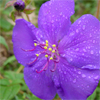Introduction

In 2001, the 1. Congress of Conservation of Biological and Cultural Diversity in the Andes and the Amazon Basin in Cusco, Peru, attempted to provide a platform to bridge the existing gap between Scientists, Non Governmental Organizations, Indigenous Populations and Governmental Agencies. This was followed by a 2. Congress in 2003, held in Loja, Ecuador together with the IV Ecuadorian Botanical Congress. The most important results of these conferences were published in Lyonia 6 (1/2) and 7 (1/2) 2004.
Since then, the "Andes and Amazon" Biodiversity Congress has become a respected institution, and is being held every two years in Loja, Ecuador, where it has found a permanent home at the Universidad Tecnica Particular.
In 2005, the 3. Congres on Biological and Cultural Diversity of the Andes and Amazon Basin joined efforts with the 2. Dry Forest Congress and the 5. Ecuadorian Botanical Congress, to provide an even broader venue.
The Tropical Dry Forests of Latin America as well as the Andes and the Amazon Basin represent one of the most important Biodiversity-Hotspots on Earth. At the same time, both systems face imminent dangers due to unsustainable use.
Attempts of sustainable management and conservation must integrate local communities and their traditional knowledge. Management decisions need to include the high importance of natural resources in providing building materials, food and medicines for rural as well as urbanized communities. The traditional use of forest resources, particularly of non-timber products like medicinal plants, has deep roots not only in indigenous communities, but is practiced in a wide section of society. The use of medicinal herbs is often an economically inevitable alternative to expensive western medicine. The base knowledge of this traditional use is passed from one generation to the next. Especially the medical use represents a highly dynamic, always evolving process, where new knowledge is constantly being obtained, and linked to traditional practices.
An increased emphasis is being placed en possible economic benefits especially of the medicinal use of tropical forest products instead of pure timber harvesting, an approach particularly appealing to countries with difficult economic conditions. Most research efforts, due to lack of manpower, time end resources, focus only on either biodiversity assessments or ethnobotanical inventories, or try to implement management and use measures without having a sound scientific base to do so. Often the needs of the local populations, e.g. their dependency on plant resources for health care are entirely ignored.
Lyonia presents the most important papers of these three conferences in parts of its 2005 and 2006 issues.
Lyonia 8(2) 2005 - Dry Forest Biodiversity and Conservation 1: Biodiversity
Lyonia 9(1) 2006 - Biodiversity and Cultural Diversity in the Andes and Amazon 1: Biodiversity
Lyonia 9(2) 2006 - Dry Forest Biodiversity and Conservation 2: Propagation and Conservation Strategies
Lyonia 10 (1) 2006 - Biodiversity and Cultural Diversity in the Andes and Amazon 2: Forest Conservation Strategies
Lyonia 10 (2) March 2006 - Biodiversity and Cultural Diversity in the Andes and Amazon / Dry Forest Conservation: Ethnobotany and Forest Use









